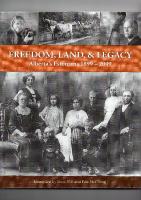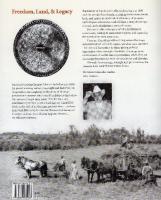Compiled and edited by Dave Kiil and Eda McClung. 2010.
Alja Pirosok
A rich and progressive legacy
Freedom, Land, & Legacy: Alberta’s Estonians 1899-2009 is a valuable publication, and a fascinating read, richly illustrated and annotated. A travelling exhibit by the publisher, the Alberta Estonian Heritage Society, will open soon in Toronto at Tartu College, in connection with the larger heritage project of which it is a part, and VEMU, the Museum of Estonians Abroad. This review will concentrate on the first part of the book that focuses on the earliest wave of migration to Canada because this material will be less familiar to most Estonian readers than the post Second World War period.
Two events, a decade apart, frame the double epic stories-within-a-story that the book represents. First, as Dr. Tamara Palmer Seiler states in her vital and comprehensive Introduction, there is the part Alberta Estonians played in “the Estonian people’s story of persistence over many centuries and, arguably, of eventual triumph against great odds”. President Lennart Meri’s words during his visit to Alberta in 2000, less than a decade after the fall of the Soviet Union and the re-emergence of an independent Estonia, strengthened the value of its heritage focus for the book’s compilers and many contributors: “the history of the Alberta Estonian community should encourage historians to look beyond the Second World War in researching the external history of Estonia.”
Moved by the story of the struggle of Alberta’s Estonian pioneers to find a new life in harsh conditions, yet not forget their roots, Meri said: “It is for me a very emotional experience to see a road sign say ‘Linda Hall.’ Linda is the wife of an Estonian national hero… we have done very little to try to discover the recorded history of Estonian archives. So with your help and interest… we will move forward”.
But the history of Estonians in Alberta is simultaneously part of another story, another history. In 1990 CBC news ran a week-long documentary series for a bewildered Canadian public on issues surrounding the “Oka Crisis”. The story of colonization and displacement of the continent’s Indigenous peoples is a dark side, as Palmer notes, of the second epic story of persistence and triumph in which Alberta Estonians played a part, the story of the building of Canada. The “Oka Crisis” was a land dispute between a group of Mohawk people and the town of Oka, Quebec. The town of Oka was making plans to expand a golf course and residential development onto land which had traditionally been used by the Mohawk. It included pineland and a burial ground, marked by standing tombstones of their ancestors. The dispute over this land was the first well-publicized violent conflict between First Nations and the Canadian government in the late 20th century. Twenty years later former Quebec Native Affairs Minister John Caccia said on CBC news: “The whole crisis could have been avoided with common sense and respect for the native community”. The segment of the 1990 CBC backgrounder that specifically focused on Alberta and the other Prairie provinces in the late 19th and early 20th centuries was titled “Legacy: Land, Power, and the First Nations”.
Like all the selections of primary and secondary sources compiled in Freedom, Land & Legacy: Alberta’s Estonians 1899-2009, the book and the film “Legacy: Land, Power, and the First Nations” tell distinct but overlapping stories. Beyond the Introduction, there are six or seven passing references in the book about Alberta’s Estonians to Canada’s Aboriginal peoples – a Medicine Valley Estonian Society lecture on ‘the plight of native Indians in Canada’, ‘stirring tales of battles between settlers and American Indians’ in the Estonian press, a native population guesstimate, trading and trapping in the bush, an Indian trail, and childhood memories of ‘Indians’ arrowheads left behind at their abandoned camps’. But at their intersections the book and the film illuminate the difficulties, injustice, and aptitudes for success specific to surviving at the edges of a new system for which both the indigenous and immigrant groups lacked language and experience.
Two salient threads in the stories of the Estonian “pioneer” era are the vivid early abundance of nature, which makes survival without cash possible, and the necessity of organizing for social protection. Readers familiar with the trials and tribulations of Tammsaare’s Põrgupõhja Uus Vanapagan may find parallels. While the Aboriginal peoples were driven to starvation, denied mobility, machinery, licenses and permits, and the legal right to organize, the early Alberta Estonian settlers endured such widespread practices as the sale of insurance and title to land that did not exist, the sale of machinery vital to increasing the proportion of cultivated land that would, however, not work long enough to pay back the debt allowable with land deeds, and market dumping of products below cost by big companies to drive out small farmers. One old Alberta Estonian settler explains in a letter: “I don’t think you know how farmers are cheated here, and how their money is extorted. I personally have lived through three big extortions”. Through no small efforts the early Estonian settlers transitioned effectively from a subsistence to a market economy - an intriguing theme - and took a leadership role in Alberta’s cooperative and union movements, while Aboriginal peoples persisted in their struggle to claim the right to organize and have emerged as leaders in recent movements to protect and restore the environment, democracy, and sovereignty itself.
Of Alberta’s Estonians themselves there are other stories-within-a-story that defy easy categorization. They are reflected in part in the major division of the book: “Alberta’s Estonians 1899-1939” and “Alberta’s Estonians 1939-2009”. Just as the “who” and the “why” of emigration to Canada differ significantly in the two periods, so too does the economic and social landscape of Alberta. For one thing, Alberta’s Estonians were not always “encouraged to exercise their own traditions and lifestyles”, especially not the “Estonian Pioneers ‘who made this land our home’” and to whom the book is dedicated. As Palmer suggests, there are related challenges in telling the story of Estonians in Canada:
There are silences in the historical records themselves, and silences resulting from the distances between people of different cultures, times and places….It is not surprising that the story of the Estonian community, with its range of experiences over time, contains a number of fault lines….Estonians are not unique in experiencing a clash of perspectives within the community defined by various waves of immigration….This dynamic…is particularly salient among…groups…whose homelands have experienced enormous political and social change over the past century.
The publication of Freedom, Land, & Legacy continues, in Palmer’s words, the “particularly rich and progressive” legacy in which the descendants of the pioneers and the post-World War II immigrants have found common ground. Drawing on personal diaries, letters, minutes of societies’ meetings, religious publications and political leaflets, financial records, interviews, and other primary sources, the book documents the energetic and enthusiastic valuing of the social spaces that “formal societies, coops, community halls, libraries, archival collections, a website” make possible, and an enduring emphasis on “education, technological innovation and cultural expression.” Wide-ranging seminar titles reveal a passion for literature and politics, and the development of musical culture spans the decades.
So who exactly, then, came to Alberta in the earlier period at the turn of the century, and why? And how exactly did they survive and thrive? They were a “handful of settlers who had been a beleaguered minority in their homeland and whose language and culture differed markedly from those of Anglo-Canadians.” They were “sailors, industrial workers, tradesmen, teachers, and a few peasants”. In the first settler, a schoolteacher, Henri Kingsep, readers may recognize a polyglot of the time, whose fear of reprisal for political activity contributed to his dream of a homestead and a fresh start. Some emigrants wished to evade service in the Russian czarist army, and there were hopes of easy wealth among Estonian seamen who had read published reports of gold. But the main attraction, in an aggressive recruitment campaign to draw the largest wave of settlers in Canadian history, was the offer of land.
It is hard to appreciate the undertaking of the Alberta Estonian settlers without some knowledge of the history and geography of Estonia, and the book does not disappoint in this regard. Palmer and Palmer’s first chapter, from Peoples of Alberta: Portraits in Cultural Diversity, places the Estonian story within the context of Canadian immigration history, while both the Introduction and the Palmer and Palmer piece also provide useful background on the international context. At the same time, the level of detail of the older historical selections, two of which were first published in Eestlased Kanadas I and are now available in English, places the experiences of particular, very resourceful and innovative, some indeed colourful, individuals and families and an evolving network of diverse communities in the foreground.
A chapter on Estonians in Alberta between the two World Wars offers a glimpse of two-way migration between Estonia and Alberta, and of the vicissitudes of the Depression, the tragedy of farms lost, and a few reclaimed when drought ended and the economy improved, owners-become-tenants-become-owners again. The move to cities and anti-“foreigner” sentiment intensified pressures to assimilate.
The second part of the book begins with the arrival of post-WWII refugees who were given entry to a prospering Canada, and ends in our post-Cold War era of pluralism and communication technology, and postcolonial Canada and Estonia.
A final chapter and website tell the story of the Alberta Estonian Heritage Society and the efforts required to produce this pioneering book. Palmer and Palmer observe that “like other groups from small countries of which Canadians have been barely aware, Estonians have faced an uphill and largely unnoticed struggle for recognition”, roadside plaques and rural cemeteries near the sites of early settlements providing silent testimony, until now the only testimony, to their presence. Alive in the memories of their children and grandchildren, their struggles and contributions have now been collected in this publication.
The Reviewer:
Alja Pirosok taught interdisciplinary humanities and ESL courses at York University from 1990 to 2008.
Book Review: Freedom, Land, & Legacy: Alberta’s Estonians 1899-2009. (3)
Eestlased Kanadas | 05 Jan 2013 | EWR
Viimased kommentaarid
Kommentaarid on kirjutatud EWR lugejate poolt. Nende sisu ei pruugi ühtida EWR toimetuse seisukohtadega.
Meri said: “It is for me a very emotional experience to see a road sign say ‘Linda Hall.’ Linda is the wife of an Estonian national hero… we have done very little to try to discover the recorded history of Estonian archives. So with your help and interest… we will move forward”.
What makes you think he didn'tnow that?
He should have known that Linda is, in fact, the mother of the Estonians' hero of the national epic.
Eestlased Kanadas
TRENDING


























